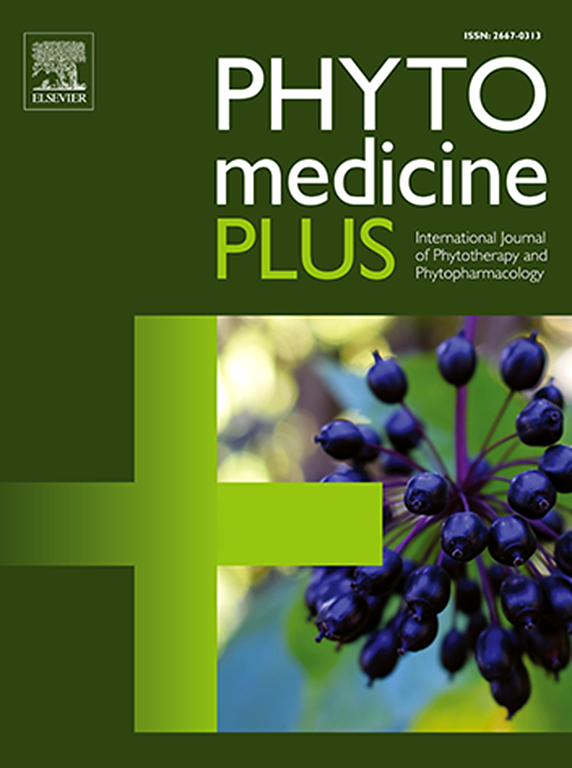Traditional Chinese medicine (Shenqinlong Qingfei Peiyuan) alleviate pulmonary infection in immunodeficient mice by suppressing HMGB1 and reversing macrophage polarization
Q3 Pharmacology, Toxicology and Pharmaceutics
引用次数: 0
Abstract
Background
Pulmonary infections are a significant concern for HIV/AIDS patients, and the role of macrophage polarization is critical in this context. Shenqinlong Qingfei Peiyuan Granules (QFPY) have been reported to alleviate symptoms of these infections. This study aims to explore the mechanisms through which QFPY reduces lung infections by regulating macrophage polarization.
Methods
We developed an immunocompromised mouse model using Balb/c mice, simulating HIV infection by inoculating them with Friend Leukemia Virus (FLV, VR-245). Pulmonary infection was induced by nasal administration of Streptococcus pneumoniae Type III (ATCC 49619). The mice received QFPY treatment for 14 days. Post-treatment, we collected thymus, spleen, and lung tissue samples. T lymphocyte counts (CD3+, CD4+, and CD8+) were measured, and CD86 and CD163 expressions in bronchoalveolar lavage fluid (BALF) from lung tissue were assessed using flow cytometry. Cytokine levels, including IL-1β, TNF-α, TGF-β1, and IL-10, were evaluated using enzyme-linked immunosorbent assay (ELISA). Additionally, HMGB1 mRNA and protein levels were measured using quantitative PCR (qPCR) and Western blot techniques.
Results
QFPY treatment showed efficacy comparable to the current standard treatment for lung infections, levofloxacin tablets (LEV). In our immunocompromised mouse model, QFPY treatment reversed thymus shrinkage, reduced spleen swelling, increased T cell counts, and inhibited M1 macrophage polarization. These effects were achieved by suppressing the expression of HMGB1.
Conclusions
QFPY effectively restored immune homeostasis and reduced inflammation in HIV/AIDS-related pulmonary infections by modulating HMGB1 expression.
中药参芩龙清肺配元通过抑制HMGB1和逆转巨噬细胞极化来减轻免疫缺陷小鼠肺部感染
背景:肺部感染是HIV/AIDS患者非常关注的问题,巨噬细胞极化在这方面的作用至关重要。参芩龙清肺培元颗粒(QFPY)有缓解这些感染症状的报道。本研究旨在探讨芪芪多糖通过调节巨噬细胞极化减少肺部感染的机制。方法用Balb/c小鼠建立免疫功能低下小鼠模型,通过接种Friend白血病病毒(FLV, VR-245)模拟HIV感染。经鼻给药III型肺炎链球菌(ATCC 49619)诱导肺部感染。小鼠接受QFPY治疗14天。治疗后,我们收集胸腺、脾脏和肺组织样本。检测T淋巴细胞计数(CD3+、CD4+和CD8+),流式细胞术检测肺组织支气管肺泡灌洗液(BALF)中CD86和CD163的表达。采用酶联免疫吸附试验(ELISA)评估细胞因子水平,包括IL-1β、TNF-α、TGF-β1和IL-10。此外,采用定量PCR (qPCR)和Western blot技术检测HMGB1 mRNA和蛋白水平。结果qfpy治疗肺部感染的疗效与目前标准治疗左氧氟沙星片(LEV)相当。在我们的免疫功能低下小鼠模型中,QFPY治疗逆转了胸腺萎缩,减少了脾脏肿胀,增加了T细胞计数,并抑制了M1巨噬细胞极化。这些作用是通过抑制HMGB1的表达实现的。结论sqfpy通过调节HMGB1的表达,有效恢复HIV/ aids相关肺部感染的免疫稳态,减轻炎症反应。
本文章由计算机程序翻译,如有差异,请以英文原文为准。
求助全文
约1分钟内获得全文
求助全文
来源期刊

Phytomedicine Plus
Medicine-Complementary and Alternative Medicine
CiteScore
3.70
自引率
0.00%
发文量
178
审稿时长
81 days
期刊介绍:
 求助内容:
求助内容: 应助结果提醒方式:
应助结果提醒方式:


